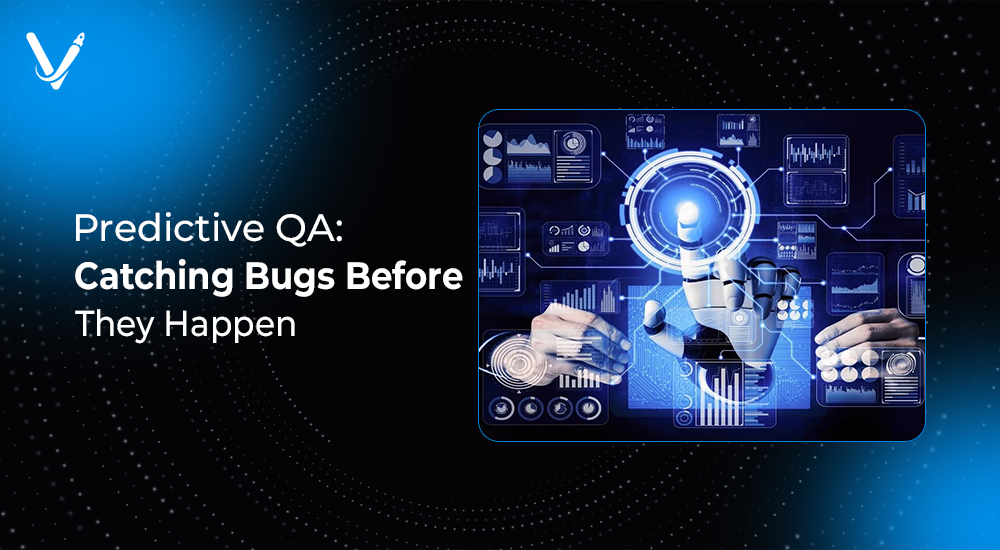Predictive QA: Catching Bugs Before They Happen


- Jul 31, 2025
In a world where software must be faster, smarter, and error-free on release, traditional quality assurance (QA)x is no longer enough. Manual tests, reactive bug fixing, and post-launch patches often fall short when businesses aim for agility and perfection. What if your QA team could anticipate bugs before a single line of faulty code reaches production? Enter Predictive QA—an intelligent, data-driven approach that is transforming how modern teams tackle software quality.
Predictive QA doesn’t just test; it foresees. By leveraging machine learning, historical defect data, behavioral patterns, and real-time code analytics, it offers a proactive shield against quality risks. This article explores the principles, techniques, real-world applications, and implementation strategies of Predictive QA, empowering teams to prevent bugs before they ever happen.
Predictive QA refers to the use of data analytics, machine learning, and AI models to forecast potential software defects, performance bottlenecks, or quality issues before they arise during production. Unlike traditional QA methods that react to known issues, Predictive QA aims to identify patterns and risk factors that historically lead to defects—before they occur.
Software complexity is growing. With increasing microservices, cloud-native deployments, distributed teams, and short sprint cycles, the margin for error has never been slimmer. Bugs cost time, money, and reputation.
Did you know?
According to the Consortium for IT Software Quality (CISQ), poor software quality cost US-based companies over $2.08 trillion in 2020—and that number continues to climb.
Data is the backbone of Predictive QA. It analyzes:
Predictive QA systems use various ML techniques:
Modern tools assign a “risk score” to every code change based on past patterns, complexity, and test history. This allows QA engineers to prioritize their testing efforts and reduce redundant efforts.
This module analyzes test effectiveness, coverage gaps, flaky tests, and identifies redundant test cases. It suggests high-priority areas to test based on current and historical trends.
It evaluates historical defect data to forecast:
Predictive QA fits seamlessly into your CI/CD pipeline. As soon as code is pushed, the system analyzes and flags potential issues—before running a single test.
Each new bug found feeds back into the system, making it smarter and better at prediction over time.
Facebook developed an internal tool that assigns a risk score to each code change. Using static analysis, code metrics, and commit history, the model predicts whether a change will likely introduce bugs. Engineers use this score to prioritize reviews and testing efforts. The result? A 44% reduction in post-deployment bugs.
Microsoft integrated ML-powered QA tools into its Azure DevOps pipeline. By predicting test failures and prioritizing risky builds, Microsoft reduced redundant test runs by over 60%, saving both time and resources.
Many SaaS startups now use tools like Testim.io, Launchable, or Harness to predict flaky tests and optimize regression testing. These systems learn over time, helping agile teams maintain velocity while ensuring software quality.
With proactive QA, teams spend less time debugging and reworking, allowing for quicker sprints and faster releases.
By focusing efforts only on high-risk areas, teams reduce the need for exhaustive manual testing, saving man-hours and infrastructure costs.
Developers are alerted about risky changes early, allowing them to correct course immediately rather than wait for QA feedback days later.
Predictive QA minimizes production bugs, leading to better user experiences, fewer hotfixes, and increased customer satisfaction.
A lack of historical data can hinder model accuracy. New teams or products might not have enough defect logs or test history to train effective models.
Teams used to traditional testing methods may be skeptical about ML-driven systems. Training and stakeholder buy-in are critical.
Overly aggressive predictions may lead to unnecessary testing or rejected commits. Models must be tuned continuously.
Ensuring predictive systems work smoothly with existing CI/CD, Jira, GitHub, or Jenkins infrastructure requires careful planning.
Begin by applying predictive models to a single module or microservice. Analyze results, iterate, and expand.
Integrate predictive alerts into your daily DevOps flow. Make risk scores visible in GitHub or GitLab PRs to guide developer decisions.
QA, development, and data science teams must work in harmony to build effective models and workflows.
Regularly track metrics like precision, recall, and false positives to ensure your predictive QA system is working as intended.
Smaller teams benefit from automated insights and smart test prioritization, allowing them to deliver quality software without a large QA budget.
Large organizations can apply Predictive QA to thousands of modules, enabling risk-based testing and efficiency at scale.
In industries like healthcare or finance, where errors are costly, Predictive QA ensures early compliance checks, data integrity, and reduced rework cycles.
Next-generation systems will use Generative AI to create synthetic test cases, simulate edge scenarios, and write test scripts automatically.
Combining predictive analytics with real-time observability tools (like Datadog or New Relic) will enable holistic risk prediction across the entire software lifecycle.
AI agents will independently decide what, when, and how to test based on live telemetry and predictions—taking quality assurance to an autonomous level.
Predictive QA is not just a buzzword—it’s a paradigm shift. Instead of reacting to issues post-deployment, organizations can now prevent them with data, automation, and intelligent models. The future of QA is no longer manual, exhaustive, or reactive. It’s smart, streamlined, and strategic.
For companies building high-impact software, Predictive QA is the competitive edge that ensures faster releases, fewer bugs, and happier users.
Ready to Future-Proof Your QA Process?
At Vasundhara Infotech, we help companies integrate AI-powered quality assurance into their development lifecycles. Whether you’re a startup or an enterprise, our predictive QA solutions are tailored to help you move faster and smarter. Reach out to us to modernize your testing strategy and build software with confidence.
Copyright © 2025 Vasundhara Infotech. All Rights Reserved.
